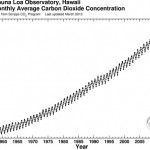Author: John Bruno
-
Humans are causing more strong hurricanes
The possible effect of global warming on the frequency or severity of cyclonic storms has been debated quite intensely among scientists (not only between scientists and climate change deniers) for over a decade. Several new studies are helping to clarify (somewhat) whether we are already experiencing (or will soon) more intense storms. Dana Nuccitelli has a…
-
Climate Change and Marine Communities 6: effects of acidification
This is the sixth installment of my serialization of a new book chapter on “Climate Change and Marine Communities” written with Chris Harley and Mike Burrows. It is for a new book “Marine Community Ecology and Conservation” that I’m co-editing with Mark Bertness, Brian Silliman, and Jay Stachowicz. The book is more or less a followup to the best-selling…
-
Why old(er) dogs can and should learn new tricks
This is a guest post by Dr Isabelle Côté, famed coral reef ecologist, documeter of gloom-n-doom, and lover of blennies. Her post is part of a conversation on science outreach centered around a commentary in PLOS Biology on the journey from science outreach to meaningful engagement. Also see related posts here, here, and here. Why old(er) dogs…
-
Seaquarium
This amazing piece is by June Zent, an Artist from my hometown (Jupiter Florida). See more of June’s work here.
-
NC legislature still trying to gag state employees
The Raleigh News & Observer is reporting that the NC legislature attempted to sneak an order gaging state employees (like me) from working on climate change (impacts, social resilience, etc). This is just one of many anti-environment legislative actions including the crazy legislation against sea level rise and the dismissal of the members of the…
-
Climate Change and Marine Communities 5: Population-level effects of ocean warming
This is the fifth installment of my serialization of a new book chapter on “Climate Change and Marine Communities” written with Chris Harley and Mike Burrows. It is for a new book “Marine Community Ecology and Conservation” that I’m co-editing with Mark Bertness, Brian Silliman, and Jay Stachowicz. The book is more or less a followup to the best-selling…
-
Climate Change and Marine Communities 4: Individual-level effects of ocean warming: ecophysiology
This is the fourth installment of my serialization of a new book chapter on “Climate Change and Marine Communities” written with Chris Harley and Mike Burrows. It is for a new book “Marine Community Ecology and Conservation” that I’m co-editing with Mark Bertness, Brian Silliman, and Jay Stachowicz. The book is more or less a followup to the best-selling…
-

Approaching 400 ppm
The atmospheric concentration of carbon dioxide is approaching 400 ppm (parts per million) for the first time in at least half a millions years. Track CO2 concentration at a great new site, with nice graphics and understandable information here.
-

A glass half full view of coral reef conservation
A glass half full view of coral reef conservation from Dr Tim McClanahan, a field ecologist for WCS. As we mark Earth Day this year with a recognition of “the face of climate change,” it is clear that the greatest threat to coral reef ecosystems is rising sea temperatures. With corals across the globe bleaching…
-
Climate Change and Marine Communities 3: Physical and chemical effects of climate change on the oceans
This is the third installment of my serialization of a new book chapter on “Climate Change and Marine Communities” written with Chris Harley and Mike Burrows. It is for a new book “Marine Community Ecology and Conservation” that I’m co-editing with Mark Bertness, Brian Silliman, and Jay Stachowicz. The book is more or less a followup to the best-selling…